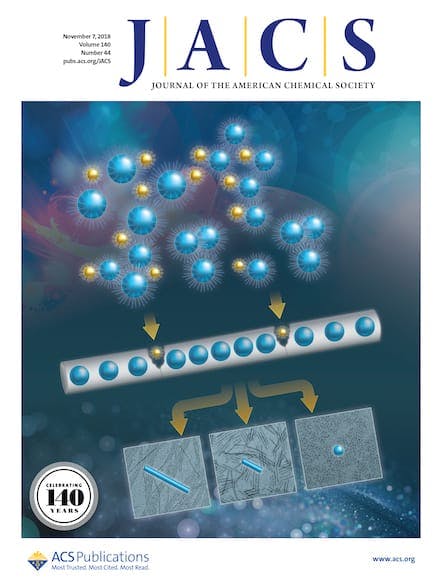Over the past year and a half, preprints have taken the chemistry community by storm. While preprint servers, such as arXiv.org, have existed for many years, it wasn’t until late 2017 that chemistry had a preprint server of its own with the launch of ChemRxiv. Since launch, ChemRxiv has hosted more than 1,200 chemistry preprints that […]

Over the past year and a half, preprints have taken the chemistry community by storm. While preprint servers, such as arXiv.org, have existed for many years, it wasn’t until late 2017 that chemistry had a preprint server of its own with the launch of ChemRxiv. Since launch, ChemRxiv has hosted more than 1,200 chemistry preprints that have been read more than 1.3 million times; offering the authors of those preprints ample opportunity to seek feedback prior to formal peer review.
All ACS journals proudly support preprints and The Journal of the American Chemical Society (JACS) has quickly become the number one ACS journal destination. JACS permits authors to submit articles based on preprints and revise them prior to acceptance as they see fit, as summarized in their updated prior publication policy here.
Check out just 7 of the 28 (and counting!) articles that are published in JACS that originally appeared on ChemRxiv. These papers are excellent examples of the high-quality research that one can find on ChemRxiv and that JACS is proud to be able to peer review and publish.
1) The first manuscript published in JACS after appearing as a ChemRxiv preprint was submitted by Igor Alabugin’s group at Florida State University in September of 2018. This thorough theoretical study on radical additions to isonitriles provides computational evidence for changes in the reactivity pattern of the reaction depending on the relative nucleo- or electrophilicity of the radicals. These findings reveal electronic and structural effects that will be useful for controlling isonitrile-mediated radical cascade transformations in a practical manner.
- Isonitriles as Stereoelectronic Chameleons: The Donor-Acceptor Dichotomy in Radical Additions
- View the ChemRxiv preprint
- View the JACS Article
2) Robert Paton and co-workers utilize modern computational approaches to tackle a challenging ion-pair reaction mechanism: the [1,3]-allylic rearrangement of chiral arylindenols. Mechanistic findings revealed in this study demonstrate the power of theoretical chemistry to further our understanding of fundamental organic reactions. The work was also selected to be featured in a JACS Spotlight article.
- Stereospecific 1,3-H Transfer of Indenols Proceeds via Persistent Ion-Pairs Anchored By NH···Pi Interactions
- View the ChemRxiv Preprint
- View the JACS Article
3) Jeffrey Long and colleagues unveil the differential pressure-induced gate-opening behaviors of three related zeolitic imidazolate frameworks upon gas adsorption. The findings in this work have broad implications for the materials science and coordination chemistry communities, as well as those interested in energy applications.
- Influence of Metal Substitution on the Pressure-Induced Phase Change in Flexible Zeolitic Imidazolate Frameworks
- View the ChemRxiv Preprint
- View the JACS Article
4) Lorenzo Di Michele and co-workers report the design and characterization of a tunable DNA nano-framework with programmable porosity. The researchers demonstrate that with this amphiphilic-DNA platform a model protein can be trapped and cycled reversibly, an important advancement in the practical application of protein-loaded crystals.
- An Amphiphilic-DNA Platform for the Design of Crystalline Frameworks with Programmable Structure and Functionality
- View the ChemRxiv Print
- View the JACS Article
5) Phil Baran’s group demonstrate a unique decarboxylative carboxylation protocol for the carbon-13 or carbon-14 radiolabeling of alkyl carboxylic acids. The radiosynthetic method is operationally simple and can be applied in pharmaceutical settings for the carbon-14 labeling of biologically-relevant compounds. This article was listed as one of the most read JACS manuscripts of January 2019.
- Direct Carbon Isotope Exchange Through Decarboxylative Carboxylation
- View the ChemRxiv Preprint
- View the JACS Article
6) Felipe Gándara and colleagues report the synthesis of multicomponent oxide materials via the calcination of a structurally controlled metal-organic framework precursor. The authors demonstrate enhanced electrocatalytic activity in the programmed multimetal oxides, suggesting the potential utility of the materials design approach in fuel cell technology. This recent publication was also featured in a JACS Spotlight.
- Encoding Metal-Cation Arrangements in Metal-Organic Frameworks for Programming the Composition of Electrocatalytically Active Multi-Metal Oxides
- View the ChemRxiv Preprint
- View the JACS Article
7) Corinna Schindler and co-workers from the University of Michigan report their efforts on the bioinspired synthesis of L-tyrosine-derived herqulines B and C. These natural products are synthetically challenging targets due, in part, to their strained macrocyclic scaffolds, piperazine moiety, and 1,4-diketone subunit. The researchers overcome these challenges with their robust synthetic strategy, which features a gram-scale route to a mycocyclosin derivative as a key synthetic intermediate.
- Bioinspired Syntheses of Herqulines B and C from Cyclodipeptide Mycocyclosin
- View the ChemRxiv Preprint
- View the JACS Article
